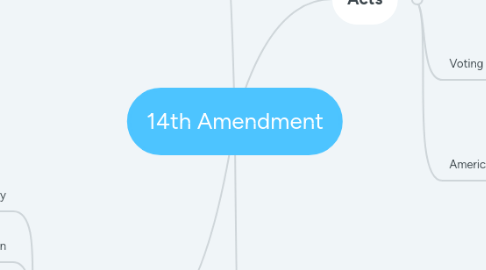
1. Amendments
1.1. 15th Amendment
1.1.1. Protects U.S citizens that voting shall not be denied no matter race, color, or previous condition of servitude.
1.2. 13th Amendment
1.2.1. Abolishes all slavery and makes it illegal in the United States.
1.3. 14th Amendment
1.3.1. All persons born or naturalized in the United States and subject to the jurisdiction. No State shall make or enforce any law which shall abridge the privileges or immunities of citizens of the United States; nor shall any State deprive any person of life, liberty, or property, without due process of law; nor deny to any person within its jurisdiction the equal protection of the laws.
2. Effects
2.1. Equal pay
2.1.1. An employer can not pay someone less based on sex.
2.2. Equal protection
2.2.1. Access to education, available jobs, higher wages, and more.
2.3. Brown v board of education
2.3.1. A case for African American equality in the United States. The Supreme Court ruled that racial segregation in the nation’s schools was a violation of the Fourteenth Amendment to the Constitution.
2.4. Same sex marriage
2.4.1. The Supreme Court’s decision made same-sex marriage legal everywhere in the United States, but not everyone agreed. Many issues also remain with discrimination in employment and housing against people based on gender identity and sexual orientation.
3. Acts
3.1. Civil rights act
3.1.1. Outlawed discrimination on race, religion, sex, and national origin. Also ended discrimination and legal segregation in public places.
3.2. Indian education act
3.2.1. Provided money and service to Native American schools and gave schools more freedom to determine their own curriculum.
3.3. Individuals with disabilities education act
3.3.1. Makes sure students receive individualized plans to accommodate with disabilities and allowed them to attend school.
3.4. Voting rights act
3.4.1. Outlawed the denial of voting rights based on race, including literacy tests. It gave federal officials a chance to help register voters who had been affected by discrimination and required lawmakers to clear any new voting policies with the federal government.
3.5. Americans with disabilities act
3.5.1. Extended equal protection to people with physical or mental disabilities. Also they included that buildings must have a railing for wheelchairs.
4. Origins
4.1. Black codes
4.1.1. Made it illegal for slaves to read, write, own property, travel without permission. Also be unemployed and get married.
4.2. Dred Scott
4.2.1. Dred Scott lived with his owner in free states for years. His owner died and Scott sued for his freedom. Supreme Court ruled that he was a descendant of an enslaved African American and was not a citizen and had no legal rights to sue.
4.3. Plessy v Ferguson
4.3.1. Supreme Court ruled that having seperate but equal facilities for different races did not violate the 14th amendment. Plessy v Ferguson made segregation legal until 1954.

